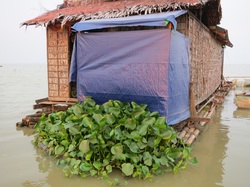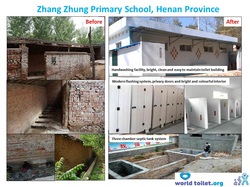Project: Cow Microloans
|
Mission: The project helps poor families generate income by raising cow, which will improve their living conditions and step by step increase the quality of their lives.
Results: The two completed pilot projects at Henan have benefited around 370 school children and teachers. Plans are underway for another two school projects in the next few months which will reach out to around 1,000 school children. |
Description: When all the cows are purchased and provided to the selected clients, the staff of Allianz Mission visits the farmer groups about every two months. AM staff meets with the whole farmer groups and individual clients to listen to their situations. This regular visiting is very important both in maintaining proper monitoring and supporting the clients with unexpected problems. AM staff usually apply participatory methods to help the clients deal with the problems. During these visits, AM staff also works closely with the local leaders in order to increase their participations and supportiveness to the project, which will enforce the local supervison over the project progress and minimize violations against the project principles and regulations. The regular presence of AM staff at the project sites is key for Allianz Mission in listening and empowering the local people, as well as transfer values.
|
Donation Impact
|
We are raising the funds necessary to produce and install HandyPods by Wetlands Work at the schools in four villages, provide sanitation and hygiene awareness training, and promote adoption of this new technology within village households. We need to scale up the use of this revolutionary product on the Tonle Sap Lake in Cambodia, and begin its launch in other floating communities around Asia and beyond. It’s never been done before, anywhere in the world.
$25 - Cost and installation of a modern and clean ceramic toilet pan at a floating school $100 - Materials to conduct sanitation hygiene and awareness campaign at a floating school $200 - Floating plant-filled lagoon to treat wastewater $300 - Floating anaerobic digestor to stabilize waste $1000 - A year-long school and community education campaign in a floating village, promoting awareness of hygiene and sanitation Tipping Point goal = $8,000 At tipping point, funds will be used to produce and install HandyPods by Wetlands Work, and run hygiene campaigns, in two schools and the wider communities on the Tonle Sap Lake in Cambodia. These funds would cover tailored design, manufacturing, and installation for each of the schools as well as training of key figures in the maintenance of the HandyPods. Sanitation campaigns will be held to raise awareness of the importance of proper hygiene and sanitation. Monitoring and evaluation activities will be conducted over the course of a year to better understand and improve on our efforts in the future. This covers HandyPod production, installation and maintenance for one year in the schools and school-wide hygiene campaigns in these villages, as well as training in proper use. Costs also include labour and administration. Ultimate goal = $20,000 The additional funding will be used to install HandyPods by Wetlands Work in two additional village schools, alongside hygiene awareness campaigns in the schools and the community. Monitoring will be carried out for a year after installation for all four schools, and the collected data will be used to make future sanitation efforts more effective. If the ultimate goal is reached, WTO and WW will travel to Bangladesh to install a HandyPod system at a floating school and conduct a sanitation and hygiene campaign, alongside a local partner. Funding of $12,000 above our tipping point will allow us to produce, install and maintain HandyPods in schools in two more villages, and to install a HandyPod system in Bangladesh to begin piloting the technology outside of Cambodia. |
The Issue
As children around the world head back to school, so do the young students living on Cambodia's largest lake, the Tonle Sap. But two things are different for these kids: their houses and schools actually float on the lake! And, unlike most schools, theirs don't have toilets, because until now, it hasn’t been possible to build one in a floating village, in their homes or their schools. Around the world, marginalized, landless populations live in floating dwellings, migrating with the seasons. Floating settlements are found in Nigeria, Indonesia, Bangladesh, Brazil, and many other nations. In Cambodia almost 100,000 people live in floating communities on the Tonle Sap Lake, with the vast majority having no access to a toilet.
There is also little awareness of the link between sanitation and health. People living in floating communities use the lake water for all their needs: bathing, washing, cooking, swimming, and drinking, and also as an open bathroom. Diarrhea-causing pathogens, including amoebic dysentery, cholera, and hepatitis, spread through contaminated water. In Cambodia, diarrheal diseases cause 1 in 7 deaths of children under 5 years of age, and those who survive frequent diarrheal episodes may suffer from developmental difficulties throughout their lives. Since the households float on water and migrate through the seasons, common sanitation technologies like pit latrines and sewers cannot be built.
While the number of Cambodian households with toilets has increased to almost 30% over the past few years, much of the efforts have targeted typical urban and rural areas. Little attention has been paid to “difficult” challenging environments such as floating villages. Simply, sanitation technologies that work in such environments have not been available.
In floating villages, neither houses nor public buildings such as schools, have latrines. At best, a house may have a toilet pan that releases untreated feces directly into the water below. Lacking other options, that same water next to the family’s house is then used for washing, cleaning, and food preparation. A lack of privacy creates additional problems for women, and contributes to absences and higher school dropout rates among female students.
There is also little awareness of the link between sanitation and health. People living in floating communities use the lake water for all their needs: bathing, washing, cooking, swimming, and drinking, and also as an open bathroom. Diarrhea-causing pathogens, including amoebic dysentery, cholera, and hepatitis, spread through contaminated water. In Cambodia, diarrheal diseases cause 1 in 7 deaths of children under 5 years of age, and those who survive frequent diarrheal episodes may suffer from developmental difficulties throughout their lives. Since the households float on water and migrate through the seasons, common sanitation technologies like pit latrines and sewers cannot be built.
While the number of Cambodian households with toilets has increased to almost 30% over the past few years, much of the efforts have targeted typical urban and rural areas. Little attention has been paid to “difficult” challenging environments such as floating villages. Simply, sanitation technologies that work in such environments have not been available.
In floating villages, neither houses nor public buildings such as schools, have latrines. At best, a house may have a toilet pan that releases untreated feces directly into the water below. Lacking other options, that same water next to the family’s house is then used for washing, cleaning, and food preparation. A lack of privacy creates additional problems for women, and contributes to absences and higher school dropout rates among female students.
The Solution
To solve this issue, Wetlands Work! (WW!), a social enterprise in Cambodia, has developed the HandyPod, a revolutionary product that floats next to a waterborne house or school and treats the sewage. The World Toilet Organization (WTO) is working in partnership with WW! to pilot the HandyPod technology in floating villages in Cambodia’s Kampong Chhnang province, as the first step in making this vital technology available to floating communities around the world.
Aquatic plants in the HandyPod host root-bound microorganisms that help to break down waste and eliminate over 99.99% of fecal bacteria. The system is self-cleaning, does not require chemical inputs to function, is easy to use and maintain. A ceramic squat pan, familiar to most users from visits to land villages, is connected to the system. The complete HandyPod is low-cost and aesthetically pleasing.
For the past three and a half years, the HandyPod has been piloted in the floating village of Akol in Pursat province, Cambodia, in all of its 35 households. We now want to introduce the system to floating schools in other areas and need funding to ensure sustainable adoption of this novel technology.
Depending on the success of this campaign we want to bring the HandyPod to a floating school in Bangladesh, where sanitation is also a challenge in waterborne communities.
We have that solution but not the funding.
Aquatic plants in the HandyPod host root-bound microorganisms that help to break down waste and eliminate over 99.99% of fecal bacteria. The system is self-cleaning, does not require chemical inputs to function, is easy to use and maintain. A ceramic squat pan, familiar to most users from visits to land villages, is connected to the system. The complete HandyPod is low-cost and aesthetically pleasing.
For the past three and a half years, the HandyPod has been piloted in the floating village of Akol in Pursat province, Cambodia, in all of its 35 households. We now want to introduce the system to floating schools in other areas and need funding to ensure sustainable adoption of this novel technology.
Depending on the success of this campaign we want to bring the HandyPod to a floating school in Bangladesh, where sanitation is also a challenge in waterborne communities.
We have that solution but not the funding.






